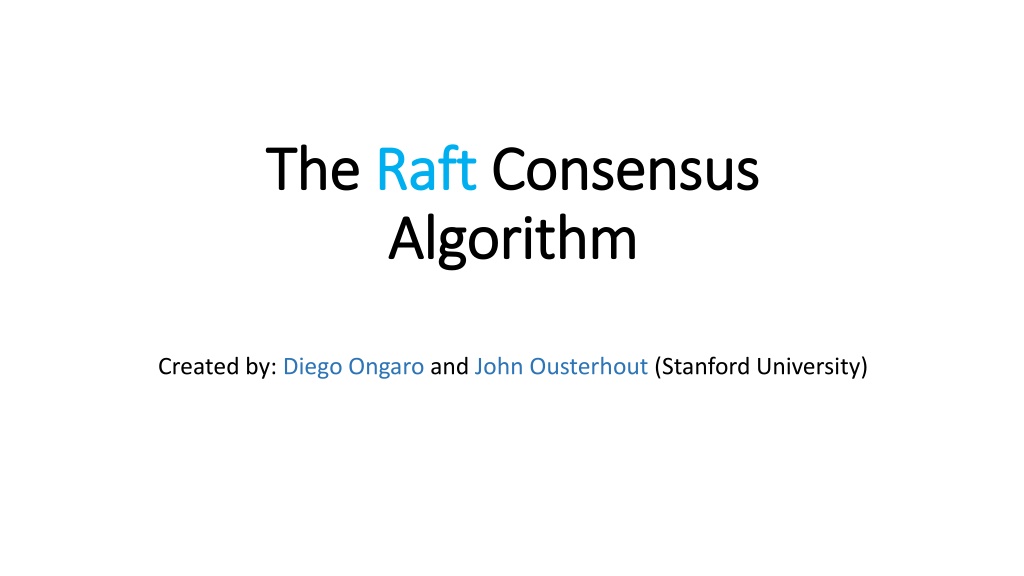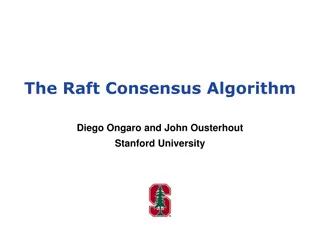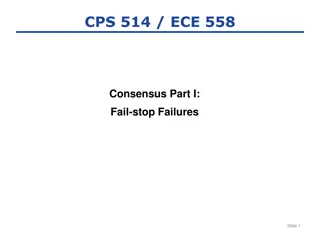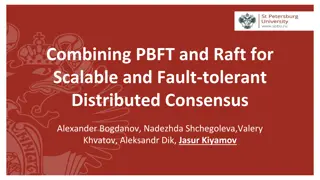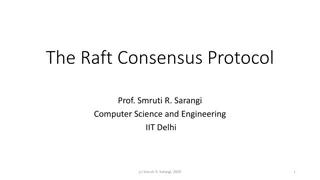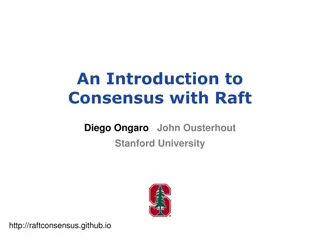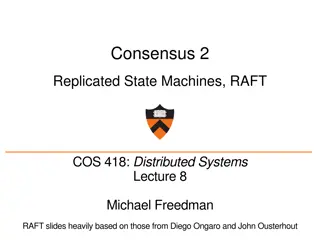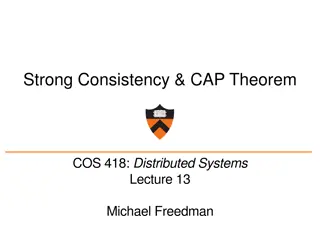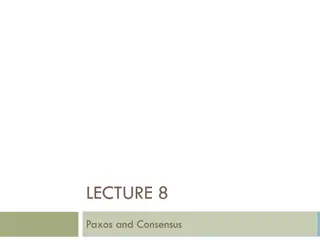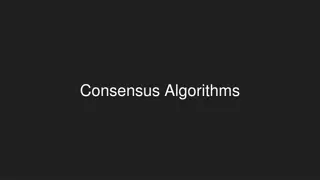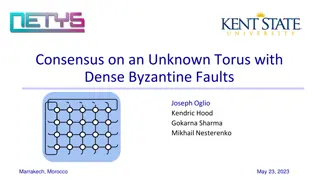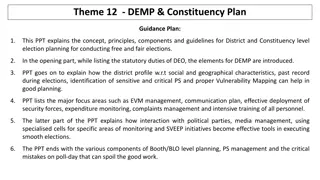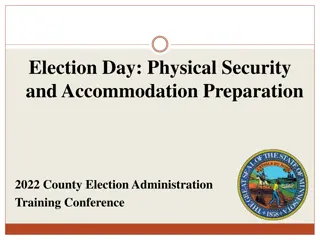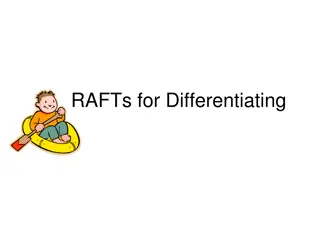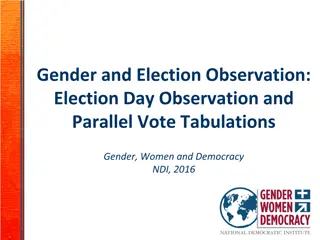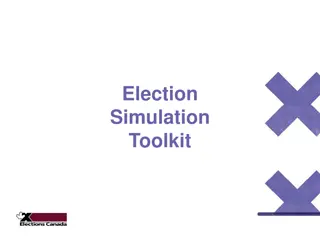Understanding the Raft Consensus Algorithm: Basics and Leader Election
Raft is a consensus algorithm designed by Diego Ongaro and John Ousterhout at Stanford University for practical systems. It simplifies understanding through leader-follower structure and terms for leader election. Nodes transition between Follower, Leader, and Candidate states, initiating elections based on heartbeat timeouts. A strong leader condition ensures a node votes accurately. Raft aims to achieve fault-tolerant distributed systems efficiently.
Download Presentation

Please find below an Image/Link to download the presentation.
The content on the website is provided AS IS for your information and personal use only. It may not be sold, licensed, or shared on other websites without obtaining consent from the author. Download presentation by click this link. If you encounter any issues during the download, it is possible that the publisher has removed the file from their server.
E N D
Presentation Transcript
The The Raft Raft Consensus Consensus Algorithm Algorithm Created by: Diego Ongaro and John Ousterhout (Stanford University)
Why Raft? Why Raft? To design an understandable consensus algorithm To design a consensus algorithm that can be implemented in a practical system without requiring too much additional engineering
The Raft Consensus Algorithm The Raft Consensus Algorithm There are two types of nodes: Leader (only one leader at a time) Followers (multiple) Initially, all nodes are followers. The leader handles all client requests Only the leader can request to write a new entry The followers respond to the leader s request
Leader election Leader election Time is divided into terms Each term starts with a new election In a term, either a node becomes a leader or there is no leader for that term (no log entries are written) Terms act as logical clock to determine the sequence of log entries
Leader election Leader election There are three states a node can be in: Follower Leader Candidate (initiates an election to become a leader) Two types of RPCS AppendEntries RPCs - heartbeat and log replication RequestVote RPCs requesting votes for being elected as leader
Leader election Leader election Each node stores a current term number increases monotonically Initially, each node is a follower and waits for a heartbeat from the leader for a duration known as election timeout (randomly selected between 150 -300 ms) If a node receives no hearbeat , it votes for itself, increases its CurrentTerm and sends out a RequestVote RPC to all other nodes- election initiation If majority of nodes vote, then the candidate becomes leader. If two nodes send out RequestVote RPC at the same time and there is no majority, no leader is elected for the term.
Leader election Leader election STRONG LEADER condition: A node X votes to a RequestVote RPC only if the following hold true- The Candidate s current term >= X s current term Candidates log is at least as up-to-date with X s log Up-to-date condition is true when the last entry in Candidate s log has a larger term number (or Candidate s log is longer in case term numbers for last entries are similar for Candidate and X) This Strong leader condition assures that an elected leader always has all of the entries committed in the previous term. Therefore, leader does not need to update its log from followers.
Leader election Leader election If a candidate receives any RPC while waiting for votes, it becomes a follower if the term of the sender is greater than or equal to its own currentTerm number and updates its currentTerm Whenever a node receives an RPC with lower term number, it rejects (ignores) that RPC- ensuring stale leaders or candidates do not affect the current term After receiving a heartbeat from leader, a follower resets its election timeout and waits for the next heartbeat If a followers election timeout expires before it receives a heartbeat or a RequestVote RPC, it becomes a candidate and initiates an election
Log Replication Log Replication Raft always maintains the Log Matching Property which ensures the following- If two entries in different logs have same index and term, then they store the same command- This is ensured by the constraint that a leader creates at most one entry with a given index in a given term. If two entries in different logs have same index and term, then the logs are identical in all preceding entries- ensured on the follower sides with a simple consistency check performed by AppendEntries RPCs.
Log Replication Log Replication Log entries in Raft:
Log Replication Log Replication Leader Side: On receiving a client request, the leader appends it to its own log and sends out an AppendEntries RPC in parallel to all other nodes. AppendEntries RPCs are also used as heartbeats when sent with no new log entries. The Leader maintains a nextIndex for each follower, which is the index of the next log entry the leader will send to that follower. The leader sends out the index number of the last committed entry with every AppendEntries RPC, which ensures that all followers eventually learn about the commit. Once the entry is replicated on a majority of servers, the entry is commited. A committed entry is written to the state machine and the index of last committed is sent via future AppendEntries RPCs
Log Replication Log Replication Follower Side: The AppendEntries RPCs with new log entries contain the index and term of the previous entry (X) (i.e., entry at nextIndex-1) in the Leader s log. The AppendEntries Consistency Check checks if the follower s log contains an entry with X s index and term. If the Consistency check does not fail, the new entries are written to the follower s log. If the consistency check fails, then: The Leader decrements nextIndex and retries AppendEntries RPC for that follower, until a point reaches where the logs match. (one failure of Consistency Check for each mismatching entry) When an AppendEntries succeeds, the follower s log is consistent with the leader s up to that entry. (The process follows for the next entries.)
Log Replication Log Replication Follower Side: If an existing entry conflicts with a new entry, the follower deletes the existing entry and all entries that follow removing the uncommitted log entries from older terms The follower then appends any new entries already not in the log this is because the leader is guaranteed to have sent all previously committed log entries If a future AppendEntries RPC says that an entry has been committed, it writes it to the State Machine
Log Replication Log Replication Therefore the leader does not have to take any special action to ensure log consistency. The failed AppendEntries Consistency checks take care of maintaining consistency if logs don t match. There is no flow of log entries from the followers to the leader.
Safety Safety State Machine Safety Property if a server has applied a log entry at a given index in its state machine, no other server will apply a different entry in the same index. Ensured by the following: A leader always contains all committed entries from previous terms Log entries from older terms are never committed by counting replicas
Safety Safety Leader Crash Scenarios: A. Leader crashes before committing an entry: The new leader may not contain all the log entries as the majority may not have replicated If the new leader does not contain the uncommitted entries, the client request is lost, but these entries are deleted from the followers which had replicated. If the new leader contains the uncommitted entries, then it will try to commit them and the client request may not be lost ( may because even this leader might fail before committing). In both cases, there is consensus.
Safety Safety Leader Crash Scenarios: B. Leader crashes after committing an entry, but before sending any future AppendEntries RPC with commit information: The majority of followers already have the entry in log So the new leader WILL have the entry in its log The new leader WILL try to commit it If this leader fails, any next leader WILL ALSO have the entry in its log The client request will not be lost and there is Consensus
Safety Safety Follower/Candidate Crash Scenario: The RPCs are sent indefinitely by the Leader The followers respond on starting Gaps are filled by the consistency check. If no leader found on starting, initiate an election.
Log Compaction Log Compaction They use Snapshotting Each server takes snapshots independently When the log reaches a fixed size (predecided)
Limitations of Limitations of Paxos Paxos (according to the authors) (according to the authors) Difficult to understand from a developer s perspective Practical implementations, more often than not, include additional modifications resulting in final systems based on an unproven protocol Leader is not well defined. Leader election is used for optimization instead of inherent consensus mechanism. Every server is both a Proposer and an Acceptor Achieving Consensus has two phases: Prepare and Accept
Raft Vs Raft Vs Paxos Paxos Raft Paxos Strong leader No leader in basic Paxos Leader does not need to update itself Leader updates missing entries from other nodes Log entries move only in one direction L -> F Log entries move in both directions L <-> F to fill holes or gaps Practical implementations do not need much engineering Practical implementations need significant engineering A node is either a Leader or a Follower All nodes are Acceptors and Proposers
